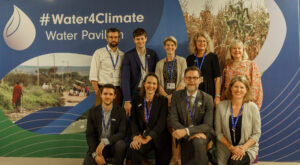Public-private Partnerships for water infrastructure
As water scarcity becomes exacerbated from climate change, the need for new investments in water infrastructure is growing. Yet, many countries, especially those who share river basins, struggle to finance such projects. In this blog post Said Hashmat Sadat tries to answer the question: Can public-private partnerships (PPP) offer a solution?

It is widely known that the financing of water infrastructure is lagging behind, compared to investments in civil infrastructure development and public utilities. Financing water infrastructure is a major global concern, as many countries are affected by funding constraints. Most actors and policymakers involved in the water infrastructure sector know that financial flows, whether from public investments or grants, are strikingly insufficient to meet the huge demand for water, food and energy. Most countries in the world, not least in shared basins, could not afford to invest unilaterally in water infrastructure-intensive sectors. In many cases, traditional donors are also reluctant to invest without a pact between the riparian countries.
Meanwhile, to meet the Sustainable Development Goals of the 2030 Agenda, massive investments are required to improve access and quality services. In this context, Public Private Partnership (PPP), as stated by the World Bank, can be a mechanism to assist governments to harness private investment for financing water infrastructure development. This approach can help countries that have problems with project implementation or financial blockages. Nevertheless, the concept of privatization in financing water infrastructure, particularly establishing an effective PPP, requires a good governance system and sound analysis so that the project design is compliant with all relevant legislation.
According to the European Court of Auditors (ECA), the PPP plays a significant role in harnessing both public and private investments as an important way to maintain or boost economic activity. However, the result of some audited projects shows that potential benefits of PPP were often not achieved. For instance, many projects did not provide sufficient added value for money. In 2019, ECA’s report found that 1.5 billion euro were not used efficiently in PPP projects due to delays or projects being underused. In order to mitigate such risks, the most important elements for establishing successful PPPs are to have sufficient human resources and administrative capacity, and to ensure that the right institutional and legal framework is in place. If these elements are lacking, there is a high chance of failure. Thus, without having consolidated experiences, sound analysis, diligence and strategic directions toward use of PPP, there is a great risk of not achieving the expected objectives. As stated in the Guidebook of the United Nations Economic Commission for Europe (UNECE), there is a need to increase the capacity of governments at all levels to implement PPPs successfully.
Therefore, in 2019 SIWI, under the auspices of the International Centre for Water Cooperation, initiated a capacity-building training to introduce PPP to the Nile Equatorial Lake (NEL) member countries. The training was facilitated through a CP3P certified consultant to let staff from the NEL’s member countries and Subsidiary Action Program (SAP) Coordination Unit learn about the main characteristics of PPP governance, including the risk of failure. The capacity-building workshops emphasized that NELSAP and member countries should improve knowledge of financial structuring and governance systems before launching any PPP. There is evidence that many PPP projects failed and were never implemented. Environmental and social considerations are always important aspects that can impact the project. For example, hydropower projects cause inundation of agricultural land and displacement of people which requires a vigilant analysis before initiating a PPP project.
Thus, improving local government capacity is crucial for bridging water infrastructure financing gaps and to encourage private investment in effective PPP solutions. With that in place, PPP can contribute to mutually beneficial development projects in shared river basins.







